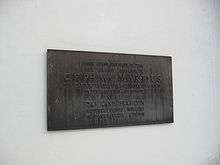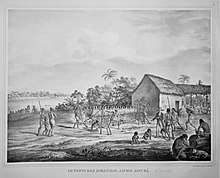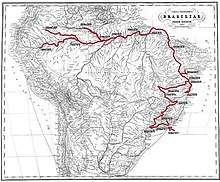Carl Friedrich Philipp von Martius
Carl Friedrich Philipp (Karl Friedrich Philipp) von Martius (April 17, 1794 – December 13, 1868) was a German botanist and explorer.
Carl Friedrich Philipp von Martius | |
|---|---|
 Martius in 1850. | |
| Born | 17 April 1794 Erlangen, Germany |
| Died | 13 December 1868 (aged 74) Munich, Germany |
| Scientific career | |
| Fields | Botany, exploration |
| Author abbrev. (botany) | Mart.[1] |
Life
Martius was born at Erlangen, the son of Prof Ernst Wilhelm Martius, court apothecary.[2]
He graduated Ph.D. from Erlangen University in 1814, publishing as his thesis a critical catalogue of plants in the university's botanical garden. After that he continued to devote himself to botanical study, and in 1817 he and Johann Baptist von Spix were sent to Brazil by Maximilian I Joseph, the king of Bavaria. They travelled from Rio de Janeiro through several of the southern and eastern provinces of Brazil and travelled up the Amazon River to Tabatinga, as well as exploring some of its larger tributaries.[3]
On his return to Europe in 1820 Martius was appointed as the keeper of the botanic garden at Munich, including the herbarium at the Munich Botanical Collection, and in 1826 as professor of botany in the university there, and he held both offices until 1864. He devoted his chief attention to the flora of Brazil, and in addition to numerous short papers he published the Nova Genera et Species Plantarum Brasiliensium (1823–1832, 3 vols.) and Icones selectae Plantarum Cryptogamicarum Brasiliensium (1827), both works being finely illustrated. An account of his travels in Brazil appeared in three volumes between 1823 and 1831, with an atlas of plates, but probably the work by which he is best known is his Historia naturalis palmarum (1823–1850) in three large folio volumes, in which all known genera of the palm family are described and illustrated. The work contains more than 240 chromolithographs, with habitat sketches and botanical dissections.[4] In 1840 he began the Flora Brasiliensis, with the assistance of the most distinguished European botanists, who undertook monographs of the various orders. Its publication was continued after his death under the editorship of A. W. Eichler (1839–1887) until 1887, and subsequently of Ignatz Urban. He also edited several works on the zoological collections made in Brazil by Spix, after the death of the latter in 1826. In 1837, he was elected a foreign member of the Royal Swedish Academy of Sciences.[3]
On the outbreak of potato disease in Europe he investigated it and published his observations in 1842. He also published works and short papers on the aborigines of Brazil, on their civil and social condition, on their past and probable future, on their diseases and medicines, and on the languages of the various tribes, especially the Tupi. He died at Munich;[3] his gravestone is decorated with two palm fronds and the Latin inscription In palmis semper virens resurgo.
A species of South American snake, Hydrops martii, is named in his honor.[5] The Martiusstraße in Munich is named after him.
Herbarium Martii

As well as a huge collection of flora specimens owned by Martius prior to his departure to South America, he returned with another 12,000 specimens which together formed the Herbarium Martii. At the time of his death the collection had been further expanded and comprised 300,000 specimens representing 65,000 species from around the world, and was one of the largest private herbaria assembled.
The Belgian government acquired the collection in 1870 which formed the basis of the then newly established Jardin botanique de l'Etat. The collection is now held as part of the National Botanic Garden of Belgium.
The Martius Project is an effort by the Botanic Garden to digitize the entire collection.[6]
Route followed in Brazil during 1817-1820 expedition

Martius and Spix, accompanied by Johann Christian Mikan who was with his wife and the artist Thomas Ender travelled to Brazil with the Austrian Commission, which joined the wedding train of Archduchess Leopoldina of Austria and Dom Pedro de Alcantara, the future Emperor of Brazil. The party left from Trieste on April 10, 1817.
The first natural history collections were made in the city of Rio de Janeiro at Laranjeiras, Corcovado, Aqueduto, Fonte da Carioca, Tijuca, Botafogo, Jardim Botanico) immediately following the wedding.
Spix and Martius then spent some days at "Fazenda Mandioca" with Grigori Ivanovitch Langsdorff and then went to a fazenda near Rio Paraiba before returning to Rio. A mounted expedition took them on horseback to Itaguaí (December 13, 1817) through São Paulo state to the city of São Paulo where they arrived on December 31, 1817. They left on January 9th, 1818 for Sorocaba and Itu on to Minas Gerais, then through Camanducaia to cross the Rio Sapucaí for São Gonçalo and Ouro Prêto. On May 1, 1818, they left for Diamantina, Minas Novas and then Montes Claros.

On August 12, 1818, they headed North-North East to Rio Carinhanha, as far as the Serra Geral then returned by Codó to Carinhanha arriving at Rio de Contas on October 17, 1818, then riding east to cross the Rio Paraguaçu arriving at Salvador on the November 10th, 1818, and leaving on February 18th, 1819 via Coit and Jacobina. The party then travelled to Piaui, Oeiras where they arrived on May 3. They departed on May 11, arriving on May 15 at São Gonçalo do Amarante, where Martius became seriously ill. Spix had at this time contracted the schistosomiasis from which he eventually died.
On June 3, 1819, they arrived in Maranhão to replenish funds and supplies. They then sailed down the Rio Itapicuru to São Luis from where they left on July 20 for Belém, arriving there on July 25, having collected specimens at several places in between. They left Belém on August 21 for an Amazon voyage, up the Tocantins to Breves, arriving in Gurupá on September 9 and Porto de Moz on the Rio Xingu on September 10. They spent September 19 through 30th in Santarém, arriving at Barra do Rio Negro on October 22 and leaving on November 2nd. They reached Tefé, then called Ega, on November 26, then split up.
Spix left Tefé on December 7, 1819, for Solimões and visiting Tabatinga before returning to Manaus on February 3, 1820. He then travelled up the Rio Negro to Moura, Barcelos returning to Manaus on February 26. Martius left Tefé on December 12th, ascended Rio Japurá, returning to Manaus on March 11, where they reunited. They departed for Belém arriving on April 16, 1820, and left for Europe on June 13, 1820.
After this journey, Martius and Spix published their account of their travels and work in Brazil.[7][8] In the appendix, they published a piece of dance music, a lundu, the earliest example of this form of music recorded, it is now known as Lundu: Recolhido por C.P.F. von Martius.[9][10]. One recording of this work is by Orquestra e Coro Vox Brasiliensis & Ricardo Kanji in their recording História da Música Brasileira - Período Colonial II.[11]
Selected publications
- Versuch einer Monographie der Sennesblätter . Junge, Erlangen 1857 Digital edition by the University and State Library Düsseldorf
- Goethe und Martius . Nemayer, Mittenwald 1932 Digital edition by the University and State Library Düsseldorf
- Martius, Karl Friedrich Philipp von (1835). Conspectus regni vegetabilis: secundum characteres morphologicos praesertim carpicos in classes ordines et familias digesti... (in Latin and German). Nuremberg: Schrag. Retrieved 9 January 2016.
- — (1824). Nova genera et species plantarum :quas in itinere per Brasiliam MDCCCXVII-MDCCCXX jussu et auspiciis Maximiliani Josephi I., Bavariae regis augustissimi instituto. 3 vols (in Latin). Munich: Lindaueri.
See also
References
Citations
- Brummitt, R. K.; C. E. Powell (1992). Authors of Plant Names. Royal Botanic Gardens, Kew. ISBN 1-84246-085-4.
- Biographical Index of Former Fellows of the Royal Society of Edinburgh 1783–2002 (PDF). The Royal Society of Edinburgh. July 2006. ISBN 0-902-198-84-X.
- Chisholm 1911.
- Plants and Gardens Portrayed: Rare and Illustrated Books from The LuEsther T
- Beolens, Bo; Watkins, Michael; Grayson, Michael (2011). The Eponym Dictionary of Reptiles. Baltimore: Johns Hopkins University Press. xiii + 296 pp. ISBN 978-1-4214-0135-5. ("Martius", p. 170).
- Martius Project
- Spix, Johann Baptist von; Martius, K. Freidrich von (1981) [1821]. Travel through Brazil: 1817-1821. Belo Horizonte/Sao Paulo: Itatiaia/Edusp.
- Lima, Edilson Vicente de (2010). "O enigma do lundu [in Portuguese=The riddle of the lundu]" (PDF). Revista Brasileira de Mùsica, Escola de Música, Universidade Federal do Rio de Janeiro. 2/23: 207-48. Retrieved 16 April 2020.
- Camargo, Guilherme de (2011). "A Viagem musical de Spix e Von Martius (1817 - 1821) [in Portuguese]". Musica Brasilis. Retrieved 16 April 2020.
- "Museu Von Martius celebra bicentenário com programação cultural". Prefeitura Guapimirim. Retrieved 16 April 2020.
- Orquestra e Coro Vox Brasiliensis; Kanji, Ricardo (2019). História da Música Brasileira - Período Colonial II. Tratore.
- IPNI. Mart.
Sources
- "Flora Brasiliensis On-Line". The Centro de Referência em Informação Ambiental, CRIA (Reference Center on Environmental Information) (in Portuguese and English). 2006-03-22. Retrieved 2008-03-13.
- "Introdução à Herpetologia do Brasil O contexto científico e político da expedição bávara ao Brasil de Johann Baptist von Spix & Johann Georg Wagler". Imaginario (in Spanish). Archived from the original on 2007-08-14. Retrieved 2008-03-13.
- "Online database of digitized works". Gallica (in French). Retrieved 2008-03-13. – click on 'Recherche' link and enter "Martius" as 'Auteur'
- Chisholm, Hugh, ed. (1911). . Encyclopædia Britannica (11th ed.). Cambridge University Press.
External links
